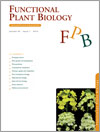
Functional Plant Biology
Volume 40 Number 7 2013
FP12325Revisiting an important component of plant genomes: microsatellites
Microsatellites (also called simple repeat sequences) are not ‘junk’ DNA with no function but a ‘jewel’ in plant genomes. We investigated the regularity of generation, evolution and decay of microsatellites, and the relationships among physical structure, variation and functionality of microsatellites. The phenotypic effects of plant microsatellites will increase our understanding of the functionality of repetitive sequences.
FP12386A survey of the natural variation in biomechanical and cell wall properties in inflorescence stems reveals new insights into the utility of Arabidopsis as a wood model
Examination of the variation of Arabidopsis thaliana from diverse locations has led to breakthroughs in understanding genes that control many important traits. Until now, the variation in A. thaliana wood properties was unknown; our assessment of 12 accessions shows that significant variation exists in wood-like growth characteristics, proportions of cell wall components and biomechanics. This hints that large-scale studies will yield genes that are important to wood formation and properties.
FP12351Sensors and imaging techniques for the assessment of the delay of wheat senescence induced by fungicides
This study assessed changes in the senescence of wheat plants treated with different fungicidal compounds using innovative sensor methods. Senescence-associated changes (degradation of photosynthetic pigments, photosynthetic activity, leaf reflectance and transpiration of plant tissue) were detected using ground-based optical sensors earlier than with destructive and visual methods. Noninvasive sensors and imaging techniques are an excellent alternative to traditional screening methods for assessing the side-effects of fungicides on plant physiology.
FP12335Delayed water loss and temperature rise in floral buds compared with leaves of Brassica rapa subjected to a transient water stress during reproductive development
The relationship between water loss in leaves and in floral buds in Brassica species has rarely been studied. The different responses of the leaf and bud in B. rapa has demonstrated a ‘self-adjustment’ mechanism in which the floral bud maintains stomatal function longer into a drying cycle than the leaf. The study suggests that bud temperature may be a useful indicator of drought tolerance in B. rapa.
FP12362Quantifying the relationship between temperature regulation in the ear and floret development stage in wheat (Triticum aestivum L.) under heat and drought stress
The relationship between temperature depression in the ears of wheat and flower development stage under heat and drought stress was examined. The early stages of anthesis were associated with a lower ear temperature than later stages, indicating that temperature depression occurs in the ear under stress and potentially during the heat-sensitive flower development stages. This pioneering study provides a framework for correlating ear temperature and grain yield under stressed conditions.
FP13028Transpiration sensitivities to evaporative demand and leaf areas vary with night and day warming regimes among wheat genotypes
Climate change is currently driving important wheat yield decreases worldwide as a result of dryer and warmer conditions. In this study we investigated the impacts of different day and night warming scenarios on key yield-determining traits directly related to the plant’s water use in order to identify potentially tolerant cultivars and the underlying tolerance strategies among a panel of 11 breeding and commercial bread and durum wheat lines. Large variability among cultivars was found, indicating common responses and also different coping strategies that could help in breeding next-generation cultivars adapted to warmer climates.
FP12228Seasonal and diurnal variation in the stomatal conductance and paraheliotropism of tedera (Bituminaria bituminosa var. albomarginata) in the field
We investigated physiological drought resistance mechanisms under field conditions in mature plants of the perennial herbaceous legume tedera (Bituminaria bituminosa (L.) var. albomarginata). Leaf folding, combined with effective stomatal control, conferred high drought resistance in summer. Measures of leaf water-use efficiency, relative leaf water content, and leaf retention also suggested high drought resistance. Variation among accessions indicates genetic diversity for drought resistance that may be valuable in future breeding programs. Tedera seems good for Western Australia’s challenging climate, having survived the arid Canary Islands climate.
FP12338Hydraulic conductance of intact plants of two contrasting sorghum lines, SC15 and SC1205
Crops, especially sorghum, are vulnerable to dry periods during the growing season that can result in yield loss. Alteration of the hydraulic conductance in the plant offers the possibility for regulated water loss from the crop to minimize the impact of drought. The results of this study with two sorghum varieties showed differences in hydraulic characteristics and that this trait does indeed offer the possibility for improving crop water use and increased yields.
FP12314Interactive effects of boron and NaCl stress on water and nutrient transport in two broccoli cultivars
In arid regions, high NaCl levels in the aquifers, and wastewater contaminated with boron have adverse effects on crops. We determined the water transport and membrane integrity of two broccoli cultivars in response to NaCl–B interaction with aquaporin involvement. An antagonistic effect of the NaCl–B interaction was observed in cv. Naxos through changes in the root hydraulic conductivity and biomass restoration, making Naxos appropriate for saline–boron irrigation.
FP12278The effects of cane girdling before budbreak on shoot growth, leaf area and carbohydrate content of Vitis vinifera L. Sauvignon Blanc grapevines
The carbohydrate availability of a developing grapevine shoot has a direct influence on shoot architecture and leaf development. The initial rate of shoot growth will determine its ability to develop adequate leaf area, which is required for growth. An estimation of the carbohydrates present in a cane or shoot can be determined by using the shoot’s or cane’s cross-sectional area, or by using the total leaf area of the shoot.



